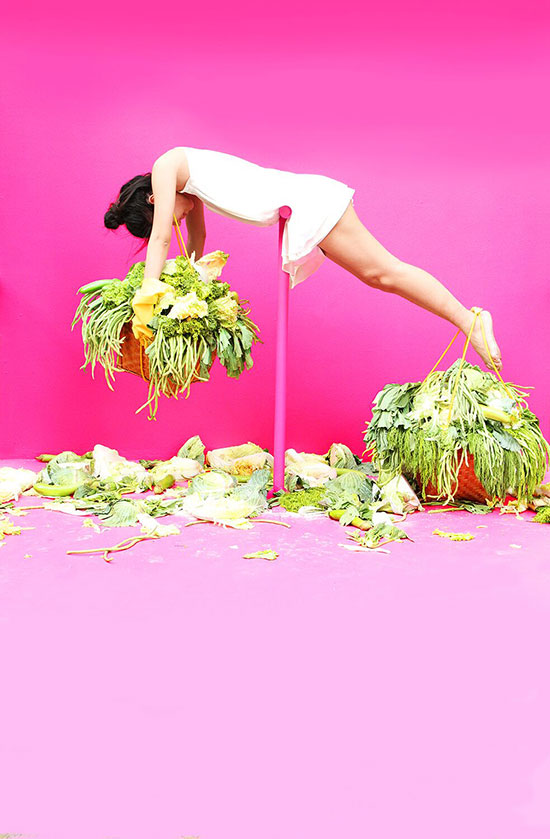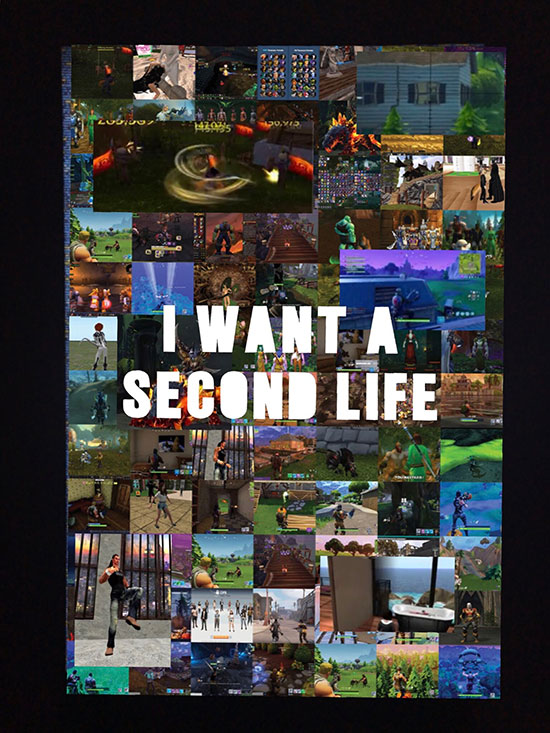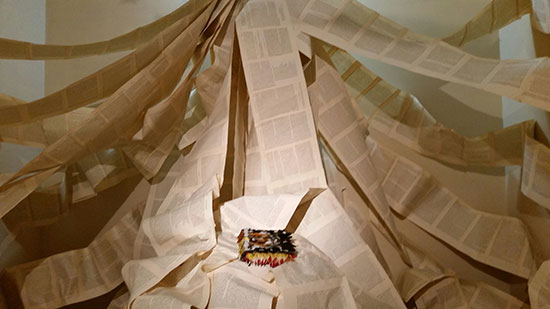Spring/Break Art Show returns to the former Condé Nast building in Midtown Manhattan for its 2018 edition. Even before gaining entrance to the elevators that whisk upward to the 22nd or 23rd floor where the art fair was held, it was easy to expect some weirdness. After all, unexpected experiences and unusual sensations are bound to happen when you're a Stranger in a Strange Land (to quote the title of the 1961 science fiction novel by Robert A. Heinlein).
Spring/Break Art Show has an official curatorial directive of "Stranger Comes To Town" which allows curators plenty of room for ideas to grow while donning conceptual thinking caps and inviting artists whose work or art practice could develop the theme. Spring/Break Art Show differs from typical art fairs as it's curator-driven (versus galleries or art dealers presenting work by their artist stable that's likely to sell). Having a single fair-wide theme that underlies all the art presented at the fair is another important difference for Spring/Break Art Show. The fair is one of my favorites for its close connection to artists and the art making process.
In general, the 2018 edition felt stronger than last year with variations on the theme to be found in every office and cubby that stretched across nearly every square inch of two floors, now filled with edgy contemporary art. Politics of national or international scales were prominent throughout the fair. And, yes, Donald Trump was either directly or indirectly referenced in multiple artist presentations.
What resonated for me was art installations that manifested an emotional aspect of what it's like be human today while revealing something of the experience of living life right now across the world. All of the work selected possesses an element of the personal whether the experiences portrayed were those of the artist or channeled through empathy. Following are six artist installations that stood out above the crowd at Spring/Break Art Show 2018.
"Rituals of Otherness" by Kawita Vatanajyankur. Curated by Alexandra Fanning
Kawita Vatanajyankur's color video installations are set upon bright and bold walls that compliment the work presented. Visually striking, each video art piece features Vatanajyankur in motion as a stand-in for a tool used for typical household chores. Strange? You bet. It's not every woman who becomes a washing machine. Intriguing? I found it difficult to drag my eyes away from the unusual circumstances the artist placed herself in, portrayed through video performance art or "moving paintings," as described in the booth description.
The reasons behind the artist deciding to star in roles of tossed laundry, clothing carrier, wet rags and vegetable scale spring from her experience of being a Thai-born woman who was raised in Australia and was trying to decide which country and culture to adopt as her adult home. Having lived in both unique cultures--that possessed different mores about women's roles--Vatanuoajyankur found herself without prized skills for Thailand, who are expected to execute household chores by hand, and felt afloat in the land of her birth, curator Alexandra Fanning said.
Stepping in to become a tool or technology for "women's work," Vatanajyankur's series "Rituals of Otherness" explores shifting definitions of what it means to be female today and the state of being human when purposes and talents can be replaced by technology and humans themselves become afloat with obsolescence.
.

"Rituals of Otherness" by Kawita Vatanajyankur. Curated by Alexandra Fanning. Courtesy of Alexandra Fanning.
.

"The Scale of Justice" by Kawita Vatanajyankur, 2017. Print and video, Edition of 4 +2 AP's, Inkjet printed on Premium Satin Photo paper, 15 x 30 inches. Curated by Alexandra Fanning.
.
“GYOPO” by Argus Paul Estabrook. Curated by Valery Jung Estabrook
At the sight of Donald Trump's contorted face in what appeared to be an angry pronunciation, I almost didn't want to walk into the installation of black and white photographs. While his image appeared historic, it was still too all familiar. Taking a breathe, I walked in any way to gaze upon a series of scenes of people locked in street protests depicted in black-and-white photography. Emotive and compositionally interesting, it was the curation of the protest pictures that ultimately convinced me to lock in for the long haul and hear the stories behind the three distinct series that made up the installation "GYOPO" by Argus Paul Estabrook.
"GYOPO" presents selections from three distinct series based on three major historic events in South Korea that are portrayed in emotive black and white photographs by a Korean-American artist living in a Korean "homeland" that is not actually his own. The protest photographs actually depicted scenes during the impeachment of South Korean President Park Geun-hye presented in a horizontal top line and aligned with public rallies both for and against Donald Trump's visit to Seoul. Strikingly similar in tone, by pairing them as related yet separate events, Estabrook's emphasis on portraying people and their emotions rise to the forefront and stays there. The show was curated by Valery Jung Estabrook, an artist in her own right and the sister of Argus Paul Estabrook.
This same concern and aim as an artist is clearly manifested in the series installed on the opposite wall. Much darker and emotionally wrenching, an installation of photographs couched with Korean writing is set against a blackboard with chalk writing in English. The work is part of an ongoing series of documenting high school students who perished beneath the water in the Sewol Ferry tragedy on April 16, 2014. All the students were from the same high school. Around 304 passengers and crew died in the tragedy.
Wanting to pay both homage to the children and block efforts to erase all physical reminders of the school they had attended, Estabrook began photographing and gathering written responses by parents and family members as messages to the one they lost. In keeping with his mission to make images that capture feelings first, the images combined with text and collaged with a background of personal confessions are a powerful reminder and testament to the human cost of loss and to lives that continue to resonate through powerful memories.
With Estabrook's work presents the intensive of being human, he presents the similarities shared in the condition of being human despite politics and cultural viewpoints that may form divides.
.

"GYOPO" by Argus Paul Estabrook. Curated by Valery Jung Estabrook at SPRING/BREAK 2018. Photo: Samuel Morgan Photography. Courtesy of Valery Jung Estabrook.
.

Installation details of "GYOPO" by Argus Paul Estabrook. Curated by Valery Jung Estabrook at SPRING/BREAK 2018. Photo: Pat Rogers.
.

Artwork by Argus Paul Estabrook. Curated by Valery Jung Estabrook at SPRING/BREAK 2018. Photo: Samuel Morgan Photography. Courtesy of Valery Jung Estabrook.
.
"A Study of Identity" by Ryoichi Nakamura. Curated by Koki Ishibashi
"A Study of Identity" was striking from the sheer number of portraits and the individual beauty held by each. Curator Koki Ishibashi of Koki Arts in Japan presented a full booth installation by Ryoichi Nakamura. Each portrait held a surface that was scarred, scored or altered in a way that partially obscured each face was both dramatic and moving, even without explanation.
Each portrait depicts a Japanese-American who was relocated to Japanese American Internment Camps, such as those located in California, Washington, Oregon and other locations, during World War II. Nakamura, who was born and currently lives in Tokyo, said that he purposefully picked a small size for each work (7 x 5 inches each) as he knew he wanted to produce hundreds of images to impart the number of people who were impacted. Using the same size for each also links people who may have been strangers together through a shared circumstance. Each work is photo emulsion on aluminum, copper or brass.
With the obscuring, the works demonstrate changes life can make upon a person especially when he or she finds themselves in unexpected circumstances, Ishibashi said. "This experience changed every one of them and they weren't the same people as they were before," he said. "Each of the ways Nakamura changed the photograph reflects this. Each surface is altered differently as each person was changed by the experience of being rounded up and sent to live in an Interment camp. It was especially powerful when we showed this work in Seattle. Many Japanese Americans looked at the pictures and found someone who looked like, who they said could have been a relative."
.

"A Study of Identity" by Ryoichi Nakamura. Curated by Koki Ishibashi. Photo: Pat Rogers.
.

"A Study of Identity" by Ryoichi Nakamura. Curated by Koki Ishibashi. Photo: Pat Rogers.
.
“Self on The Shelf” by Laia Cabrera and Isabelle Duverger. Curated by Christine Miele.
"Self on The Shelf" was a distinct departure from the installations and room presentations that dominated the fair. Presenting as a child's bedroom, the work was enlivened through the act of finding and pressing a black button to present a series of changing environment that combined a childlike innocence with adult self-examination that didn't scour. In an unexpected twist, the work contained a live projection component so participates could see themselves appear on the walls as part of the art installation. It's all part of the dreamlike environment and secret places that is more nice than not.
"Self on The Shelf" was dreamed up by a pair of visual artists with skills in projected mapping, film, video, animation and visual art. Add in an interaction designer, with skills in music video and engineering, a product designer to create toys to play with, along with an art director and a curator to create the full team to create the temporary environment.
Experiencing the installation was not nearly as complicated as the list of skills needed to create the fanciful work. The work is inspired by a childhood toy by the curator's son. His "Elf on the Shelf" was a toy that was a stand in for Santa Claus and, as part of his Christmas team, could report back on whether he was naughty or nice to determine the level of gifts delivered on Christmas Eve.
"The Self on The Shelf" can transform into both sweet dreams or nightmares where elves take over the room or storms envelop the room. Other actions will create the room to transform into a pool, a drawing that unfolds or to place the visitor in the room as way of looking themselves in the mirror.
Overall, the installation was a fun breathe in an art fair with work that could be heavy on the heart or harsh on the eyes.
Interactivity was provided by Nicola Carpeggiani, product design by Amy Pilkington and art direction by Laura Valenzuela. Music and sound design was created by Laia Cabrera and Isabelle Duverger.
.

“Self on The Shelf” by Laia Cabrera and Isabelle Duverger with Interactivity by Nicola Carpeggiani. Photo: Samuel Morgan Photography. Courtesy of Laia Cabrera.
.

“Self on The Shelf” by Laia Cabrera and Isabelle Duverger with Interactivity by Nicola Carpeggiani. Photo: Samuel Morgan Photography. Courtesy of Laia Cabrera.
.

“Self on The Shelf” by Laia Cabrera and Isabelle Duverger with Interactivity by Nicola Carpeggiani. Photo: Samuel Morgan Photography. Courtesy of Laia Cabrera.
.
“Double Life” by Jonathan Rosen. Curated by Wallplay (Laura O’Reilly, Alessandra De Benedetti & Regina Harsanyi) with AR powered by Blippar
At first glance, Jonathan Rosen's series "Double Life" is text art driven by a single powerful statement set on a confetti of color. Easy to like (and to chuckle over), the work became intriguing upon close examination. Rosen constructed each work using collaged computer source code taken from (with permission) websites that relate to the dramatic pronouncements.
For instance, code for I WANT TO BE LOVED was excerpted from the dating site OK Cupid and references men and women who created fake accounts to catfish potential lovers, Rosen explained. Code accompanying I WANT TO BE ANONYMOUS originates from Reddit's Controversial section and references the practice of internet trolling. Words or phrases highlighted in color include "Invisible"; "score dislikes"; "HideHideHide"; "nofollow"; "unvoted"; "class" and others.
Taking the work a step further, Rosen teamed up with Wallplay, a company that assists artists working with technology. Wallplay executives Laura O'Reilly, Alessandra De Benedetti and Regina Harsanyi teamed up with Blippar to add an AR (Augmented Realty) layer to the work. In the booth, they trio manned portal devises to ensure everyone could see the way the work was transformed.
In I WANT TO BE LOVED, the faces of the catfishes are revealed and appear as a collaged matrix. By the use of AR, double lives and secrets become visible to the public mimicking the way Social Media has easily transformed moments from private lives into fodder for public consumption. How real any of this is become a matter to ponder and explore, Rosen said.
.

“Double Life” by Jonathan Rosen. Curated by Wallplay (Laura O’Reilly, Alessandra De Benedetti & Regina Harsanyi) with AR powered by Blippar. Courtesy of Wallplay.
.

"I Want a Second Life" by Jonathan Rosen, 2018. Light box with dye sublimation print on fabric. Augmented reality collage including mp4 and png files in 2018 version, 48 x 3 x 72 inches, Edition 1/3. Courtesy of Wallplay.
.
“The Poetry of Earth” by Rachel Marks. Curated by Che Morales
Receiving the award for "Most Whimsical" would be "The Poetry of Earth" by Rachel Marks. The American artist, dancer and performer who is currently living in Paris created a physical fairy tale land in an immersive installation created through collaged and repurposed books. Adopting poetry as a guiding light (versus the prose found within the former book's pages), the paper sculptures were enchanting and technically amazing in the way they seems as if it was no effort at all to construct exposed tree trunks from books, a sky filled with flapping words and a dramatic alter that would seem quite at home for any grail-centric story.
Bringing the fairy tale quality to life personally, Marks donned a wreath and flowered tights for opening night. For a city dweller such as herself, nature is a rarity and being among the earth's natural offerings is an experience that's not frequent but craved. The earth has its own poetry and songs and possesses a power of restoration. By using discarded books as material chosen for their texture and sculptural qualities, she aims to bring the raw material back full circle to its natural state: from tree to paper to art in the form of trees and nature.
.

Artist Rachel Marks snd Curator Che Morales with “The Poetry of Earth." Photo: Pat Rogers.
.

Detail from “The Poetry of Earth” by Rachel Marks. Curated by Che Morales. Photo: Pat Rogers.
.
_____________________
BASIC FACTS: Spring/Break Art Show is presented March 6 to 12, 2018 at 4 Times Square, New York, NY 10036. www.springbreakartshow.com.
_____________________
Copyright 2018 Hamptons Art Hub LLC. All rights reserved.
